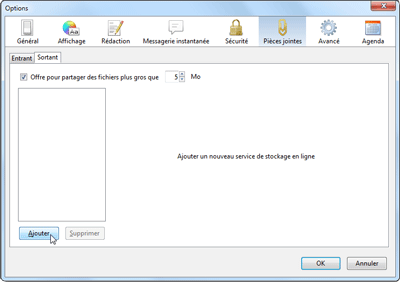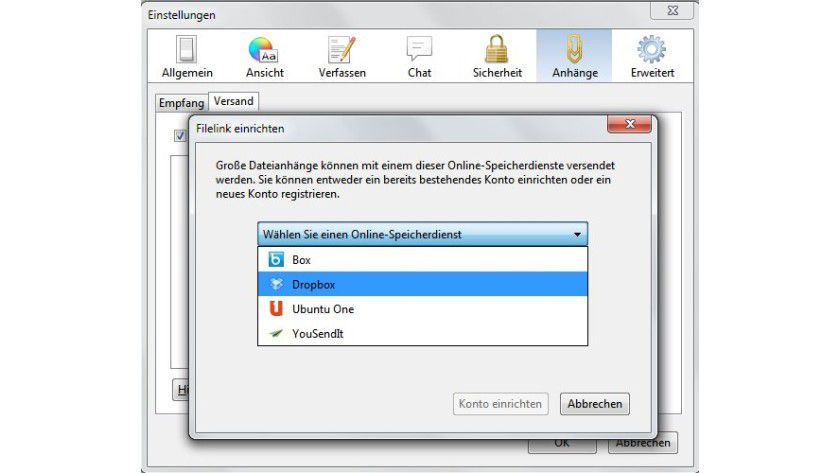FileLink機能はファイルを添付する代わりにBoxへファイルをアップロードしてBoxの共有リンクを送信できる機能です。 Filelinkの設定方法. Thunderbird のオプションを開いて、添付ファイルを選択し、送信タブを選択します 追加ボタンをクリックしてBoxを選択. Thunderbird Filelink eliminates this problem by providing support for online storage services. It allows you to upload attachments to an online storage service and then replaces the attachment in the message with a link. The message recipient clicks the link to download the attachment.
Many email servers do not accept messages with large file attachments. The file size restriction varies depending on the mail server configuration. While you might be able to send a message with a large attachment, the receiving mail server might refuse to accept a message with a large attachment. This is all beyond the control of Thunderbird.
Thunderbird Filelink eliminates this problem by providing support for online storage services. It allows you to upload attachments to an online storage service and then replaces the attachment in the message with a link. The message recipient clicks the link to download the attachment. As additional benefits, sending and receiving large files is much faster and both you and the recipient will save disk space.
Note that you can use Thunderbird Filelink in addition to conventional attachments. For example, you can attach small files directly to a message and use Filelink for large attachments in the same message.
The instructions below show how to configure and use Filelink with the Box online storage provider. We have an agreement with them to integrate their services into Thunderbird as well. (We used to have an agreement with Hightail, formerly YouSendIt). However, the community has been active in adding other providers through the use of add-ons with FileRun, hubiC, Mega, ownCloud-based services, Pydio (formerly AjaXplorer), Synnefo, and ~okeanos currently having add-ons.
Table of Contents
- 3Filelink FAQ

To use Filelink, you must first create a new account (or configure an existing account) with an online storage service provider.
- At the top of the Thunderbird window, click the Tools menu and select OptionsIn the menu bar, click the Thunderbird menu and select PreferencesAt the top of the Thunderbird window, click the Edit menu and select Preferences, or click the menu button and choose OptionsPreferences.
- Select the Attachments panel and choose the Outgoing tab.
- Click the button. The Set up Filelink panel will open.
- Select the desired service provider from the drop-down list.
- Choose Box, click , or click the Get a Box account… link to create a new account. Note: In order to set up a different account, you need to install an add-on for its provider first (see below.)
- Choose Box, click , or click the Get a Box account… link to create a new account.
- Click to continue.
If you are creating a new account, a browser window will open that displays the service provider's registration page. Create an account as instructed. The service provider will send you a validation email message. Click the validation link in the message to activate your account. Enter your username (your email address) in the dialog shown above and enter your password when prompted.
In the main configuration dialog, check Offer to share for files larger than and specify a file size (in megabytes) if you want Thunderbird to prompt you to use Filelink when a message attachment exceeds the specified size.
When you attach a file to a message and the file size exceeds the size you have specified above, Thunderbird will automatically offer you the use of Filelink:
To force a file to be attached using Filelink (rather than relying on Thunderbird to determine if the attached file exceeds the specified size), you can click the down arrow next to the button on the message toolbar to access the Filelink menu option.
Click the button to upload the file to the online storage service provider. (Alternatively click to attach the file as a conventional attachment.)
When you select the displayed message will update to:
When the linking is complete – that is your attachment has been uploaded to the service provider – your email will be modified and a block of text and a link will be added to the body of your email as shown below:
When the recipients receive the message, they will see the same information and clicking the link in the message will take them to a download page to download the attachment.
Attachments that you send via Filelink are not stored on Mozilla servers. Each file storage service provider has its own privacy policy and terms of service. The file storage service provider has reviewed the Filelink feature to ensure that it is consistent with their policies.
Q: Does Mozilla know which provider the user has picked?
A: No. Mozilla is unaware of which provider has been selected by a user. Provider configuration is stored on the local machine.
Q: What storage services are currently supported?


A: We have reached an agreement with Box to integrate their services directly into Thunderbird. The agreement with Hightail is no longer valid. You can install support for more providers with add-ons, like:
- DL for Thunderbird may be the best if you prefer using your own server instead of relying on third-party providers.
- Last but not least, you can use Filelink with a WebDAV server with the WebDAV for Filelink add-on.
Q: Can the storage service view my attachments?
A: Unless you encrypt the file before uploading, the storage services will be able to view the file, as will anyone who obtains the link to the attachment. Users must decide on their own which service provider they trust with that responsibility. (Service providers generally explain your privacy rights in their terms of service.) Note that standard attachment functionality is also not encrypted. When you send an attachment the 'normal' way, the file can be accessed by anyone that can access the message between your system and the recipients system (such as your email service provider). Filelink adds some security as file uploads to the storage service provider are sent via HTTPS, a secure protocol.
Q: How long will my file be available on the storage service provider's site?
A: The file will remain available on the storage service provider's site until you specifically delete it. Log in to the provider's website to view and delete the files in your storage space.
Q: Can you support service provider X or protocol Y?
A: We plan to support SpiderOak. We also have an 'Up-for-grabs' project available if anybody would like to add support for more services or protocols. Also have a look at the Developer documentation for the Filelink feature.
Q: I don't like the idea of storing my files with third-parties like this. Do regular attachments still work?
A: Regular email attachments still work the same as they always have. We've just given you the ability to choose to upload large attachments somewhere else, if you wish. Thunderbird's notion of a large file defaults to 1 MB, but can be customized in Thunderbird's Preferences:
- At the top of the Thunderbird window, click the Tools menu and select OptionsIn the menu bar, click the Thunderbird menu and select PreferencesAt the top of the Thunderbird window, click the Edit menu and select Preferences, or click the menu button and choose OptionsPreferences.
- Select the Attachment panel and choose the Outgoing tab.
- Set the file size for the Filelink warning.
The offer to upload can also be disabled entirely by removing the selection from the Offer to share for files larger than option.
Filelink is a Thunderbird feature that makes it easy for users to upload large attachments to web-based storage services such as Hightail.
This document explains how to extend Thunderbird to support additional web-based storage services.
nsIMsgCloudFileProvider
Filelink storage providers must implement the nsIMsgCloudFileProvider interface. The Hightail implementation is a great place to look for examples and inspiration.
The nsIMsgCloudFileProvider implementation must be registered as a component. If the provider is being merged into the comm-central code repository (and thus added to the official Thunderbird build), you must also add the components to the cloudfile/cloudFileComponents.manifest, cloudfile/jar.mn, and installer/package-manifest.in.
If the nsIMsgCloudFileProvider is being created as part of an add-on, the add-on must register the component in chrome.manifest. Also, you must add the component's contract ID to the 'cloud-file' category. See cloudfile/cloudFileComponents.manifest for an example, as well as this document on chrome.manifest files.
The Account Setup Dialog
The account setup dialog allows the user to select what account type they would like to create from a menulist.
Some providers require Thunderbird to do very little in order to connect a user to their account. Other providers however may require the user to fill in additional details in order to connect to the service. Hightail, for example, requires a username and password. Other services may require the user to fill in a server string or port number.
A provider implementation can choose what information it gets from the user from the setup dialog by pointing the settingsURL attribute of their nsIMsgCloudFileProvider implementation to a chrome URL for an XHTML page that contains a form with the extra information. That URL is then loaded into an IFrame directly beneath the provider menulist.
Filelink Free Download
Custom settings fields
To handle custom settings, the settings XHTML page should contain a form with the id 'provider-form', with its onsubmit attribute set to 'return false;'.
Example:
The form is expected to use HTML5 form validation. For each input event, the checkValidity method of the form is automatically called. The button to set up the account will only become enabled once the checkValidity method for the form returns true.
Saving custom settings in preferences
Custom settings for a provider are saved using the Preferences API.
Saving the preferences is handled automatically by the dialog code. Providers need only provide an extraArgs function in the IFrame content which returns an object specifying the name, type, and value to save.
The format for the returned object is:
Where FIELD_TYPE is 'int', 'bool', or 'char'.
Mozilla Thunderbird Filelink
For example, the Hightail implementation provides the following function:
In this example, the username value is read from the input, and then the specially-crafted object is returned. Once this is done, the field is accessible from within the implementation via the Preferences API using the key mail.cloud_files.accounts.ACCOUNT_KEY.username where ACCOUNT_KEY is the value passed into the implementations init function.
The Hightail settings.xhtml and settings.js file have examples of this.
Thunderbird Filelink Wetransfer
Management interface

Once an account has been created, it is manageable from within the Preferences dialog, in the Attachment pane, in the Outgoing tab.
The content to the right of the menulist is an IFrame, pointed at a URL read from the providers managementURL attribute, which should point to an XHTML page.
The XHTML page should have a function in the global scope called onLoadProvider. This function is called automatically once the DOM content is done loading, and is passed a single parameter - the provider instance whose data is being displayed.
